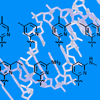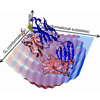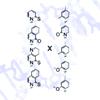Characterization of alkaline transitions in ferricytochrome c using carbon-deuterium infrared probes
P. Weinkam, J. Zimmermann, L.B. Sagle, S. Matsuda, P.E. Dawson, P.G. Wolynes, F.E. Romesberg, Biochemistry (2008) 47:13470-13480.
 We use a combination of experiments and simulations to provide a high-resolution view of the structural changes in cyt c with increasing alkaline conditions. Alkaline-induced transitions were characterized under equilibrium conditions by monitoring IR absorptions of carbon−deuterium chromophores incorporated at Leu68, Lys72, Lys73, Lys79, and Met80. The data suggest that at least four intermediates are formed as the pH is increased prior to complete unfolding of the protein.
We use a combination of experiments and simulations to provide a high-resolution view of the structural changes in cyt c with increasing alkaline conditions. Alkaline-induced transitions were characterized under equilibrium conditions by monitoring IR absorptions of carbon−deuterium chromophores incorporated at Leu68, Lys72, Lys73, Lys79, and Met80. The data suggest that at least four intermediates are formed as the pH is increased prior to complete unfolding of the protein.
 We examine the ability of five different polymerases (family A polymerases from bacteriophage T7 and Thermus aquaticus, family B polymerases from Thermococcus litoralis and Thermococcus 9°N-7, and the family X polymerase, human polymerase β) to replicate DNA containing four different unnatural nucleotides bearing predominantly hydrophobic nucleobase analogs, and we identify some aspects of recognition that are conserved.
We examine the ability of five different polymerases (family A polymerases from bacteriophage T7 and Thermus aquaticus, family B polymerases from Thermococcus litoralis and Thermococcus 9°N-7, and the family X polymerase, human polymerase β) to replicate DNA containing four different unnatural nucleotides bearing predominantly hydrophobic nucleobase analogs, and we identify some aspects of recognition that are conserved. We demonstrate that the pyridyl nucleobase scaffold can be optimized for replication, both as a self pair and as a component of a heteropair, and we identify a pyridyl-nucleotide self pair that is well recognized by a DNA polymerase, allowing it to be replicated and used to synthesize site-specifically labeled DNA in good yields.
We demonstrate that the pyridyl nucleobase scaffold can be optimized for replication, both as a self pair and as a component of a heteropair, and we identify a pyridyl-nucleotide self pair that is well recognized by a DNA polymerase, allowing it to be replicated and used to synthesize site-specifically labeled DNA in good yields. Editorial comment for the special issue of Current Opinion in Chemical Biology describing several novel approaches to developing therapeutics that target both bacterial and human proteins.
Editorial comment for the special issue of Current Opinion in Chemical Biology describing several novel approaches to developing therapeutics that target both bacterial and human proteins. We examine a panel of antibodies elicited to the chromophoric antigen fluorescein. On the basis of isothermal titration calorimetry, we select six antibodies that bind fluorescein with diverse binding entropies, suggestive of varying contributions of dynamics to molecular recognition. We find that more than half of all the somatic mutations among the six antibodies are located in positions unlikely to contact fluorescein directly, and using 3PEPS and TG spectroscopy, we find a high level of dynamic diversity among the antibodies.
We examine a panel of antibodies elicited to the chromophoric antigen fluorescein. On the basis of isothermal titration calorimetry, we select six antibodies that bind fluorescein with diverse binding entropies, suggestive of varying contributions of dynamics to molecular recognition. We find that more than half of all the somatic mutations among the six antibodies are located in positions unlikely to contact fluorescein directly, and using 3PEPS and TG spectroscopy, we find a high level of dynamic diversity among the antibodies. We report a preliminary analysis of (methyl-d3) methionine residues, Met16, Met20, and Met42, within DHFR. The results confirm the sensitivity of the carbon−deuterium bonds to their local protein environment and demonstrate that dihydrofolate reductase is electrostatically and dynamically heterogeneous.
We report a preliminary analysis of (methyl-d3) methionine residues, Met16, Met20, and Met42, within DHFR. The results confirm the sensitivity of the carbon−deuterium bonds to their local protein environment and demonstrate that dihydrofolate reductase is electrostatically and dynamically heterogeneous. To further understand the mutagenic response to DNA damage, we screen a collection of 4848 haploid gene deletion strains of S. cerevisiae for decreased damage-induced mutation of the CAN1 gene, and we identify a pathway of induced mutation that involves a replicative polymerase and that is effectively inhibited by the RNR inhibitor, hydroxyurea.
To further understand the mutagenic response to DNA damage, we screen a collection of 4848 haploid gene deletion strains of S. cerevisiae for decreased damage-induced mutation of the CAN1 gene, and we identify a pathway of induced mutation that involves a replicative polymerase and that is effectively inhibited by the RNR inhibitor, hydroxyurea. We identify the UBP dSICS:dMMO2 by screening a pool of 3600 candidate base pairs. From the results of these studies, we designed an optimized base pair, d5SICS:dMMO2, which is efficiently and selectively synthesized by Kf within the context of natural DNA. Read more in
We identify the UBP dSICS:dMMO2 by screening a pool of 3600 candidate base pairs. From the results of these studies, we designed an optimized base pair, d5SICS:dMMO2, which is efficiently and selectively synthesized by Kf within the context of natural DNA. Read more in